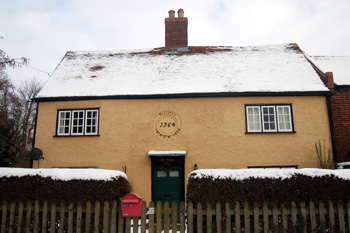Early Education in Cardington

Cardington church from the south-east March 2007
The Bishop of Lincoln carried out visitations to Bedfordshire in 1717 and 1720 and for both of these a list of questions was sent out in advance, one of which enquired about the provision of schools in each parish. At both visitations it was recorded that no schooling of any sort was available for poor children in Cardington.
By 1782 there was a school in the village. We know this because the schholmaster, James Lilburne, carried out surveys of the parish in that year [P38/28/1/1-2] and in 1794 [W6/2/1-3]. He lived at the schoolhouse which was the property today called Lilburne House, 276 Bedford Road. The surveys show that all the children in the village were schooled at the expense of either Samuel Whitbread I or John Howard, making Cardington a rare, and therefore, fortunate place to live. The 1782 survey [P38/28/1/2] stated that the occupier of The Cottage was John Preston, a 48 year old labourer, born in the village, who died on 25th November 1788. His 45 year old wife Elizabeth, née Cox, had been born in Wilshamstead and kept a school. This was probably a Dame’s School at which children were taught the rudiments of reading and writing whilst learning handicrafts such as lace making which paid for their education. In 1794 [W2/6/1-3] the occupant was Ann Morgan and no reference to a school was made.

Rear of 276 Bedford Road Christmas Eve 2010
On 27th April 1802 Thomas, son James Lilburne wrote a report on his father's old school, by that time his father was working for Samuel Whitbread and a new master taught at the school [W1/849]: "Mr. Evans's School consists of 18 Boys taught to Read and wright [sic]. 12 of whom are annually cloathed [sic]; the Expence of their Education per Annum is about £25/8/-. The Annual Expence of their cloathing [sic] is about £16. The above school I believe to be well attended to".
In 1782 there was also a school run at The Cottage by Elizabeth Preston. This was probably a Dame’s School at which children were taught the rudiments of reading and writing whilst learning handicrafts such as lace making which paid for their education. In 1794 [W2/6/1-3] the occupant was Ann Morgan and the school had ceased.

The Cottage Christmas Eve 2010
In 1818 a Select Committee was established to enquire into educational provision for the poor. This was no doubt prompted, in part, by the recent foundation of two societies promoting education and specifically the building of schools. The Society for Promoting the Lancasterian System for the Education of the Poor was established in 1808 promoting schools run along the lines pioneered by Joseph Lancaster, who had himself copied those of Dr.Andrew Bell, in which older children taught their younger fellows. The Society was renamed the British and Foreign School Society in 1814. It was supported by a number of prominent nonconformists, Lancaster himself was a Quaker, and sought to teach a non-sectarian curriculum. In answer to this perceived nonconformist takeover of local education the National Society was formed in 1811 to encourage the teaching of poor children along Anglican lines, including the catechism. The Select Committee sent a questionnaire to all parishes in the country asking for: particulars relating to endowments for the education of children; other educational institutions; observations of parish needs etc. Rev.Frogmore Cumming, the vicar, reported the school in Cardington as maintained by a ‘principal inhabitant’ and the parents of the pupils, of which there were about 24. He felt that the poor would have sufficient means of education if the new [i.e. National Society] system was introduced.
In the country generally the number of schools built continued to grow over the next fifteen years so that by 1833 the government agreed to supplement the work of the two societies, and local benefactors, by making £20,000 per annum available in grants to help build schools. It also prompted another questionnaire to be sent to each parish in England asking for details of local educational provision. In Cardington there were two daily schools; one in Eastcotts, then a hamlet of Cardington, which taught 40 boys and 40 girls, the other in Cardington containing 2 boys, and 9 girls who were educated at the expense of the parents. In addition there were four Sunday schools; the Church of England School was attended by 60 children; in the others there were 81 boys and 114 girls supported by voluntary contributions from the dissenting congregations. A report of 1844 by an inspector noted that the ‘Master appears to me sadly deficient in temper and skill’. In those days a Sunday School was just that, a school which met on a Sunday, usually in the church or nonconformist chapel or other similar building, teaching more than the religious topics with which they are associated today.